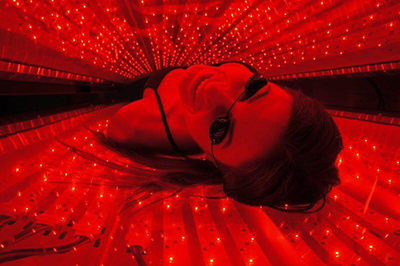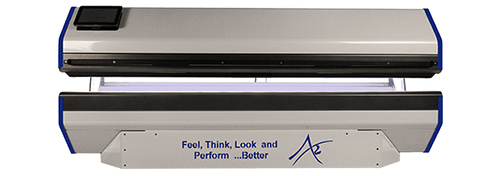Whole Body Red Light Therapy (Photobiomodulation)
What is Red Light Therapy?
The therapy applies different wavelengths of light at different intensities and pulse rates to affect or modulate the body's biological function. Cellular optimization cascades down into and benefits nearly every tissue, organ and system in the body.
Red light therapy stimulates natural cellular processes, similar to how specific wavelengths (at the opposite end of the light spectrum) can be used to treat psoriasis or vitiligo.
Red light therapy (also known as Photobiomodulation) uses a combination of red and near-infrared light to activate a number of biological processes.
Key Performace Gains
- 38% More Force - Patients treated with PBM were able to generate, on average, 38% more force (64.14 N.m.) than those that received a placebo treatment (46.52 N.m.)
- Exercised 19% longer - Competitive cyclists increased the average time they could exercise before reaching exhaustion by 19% when treated with PBM (177s) when compared with cyclists that received a placebo (149s)
- 42% less DOMS - Recipients of PBM suffered from significantly less from DOMS than those that were given a placebo treatment, measured on the visual analogue scale
Benefits of Red Light Therapy
The Whole Body Photomodulation Bed is used for improving blood circulation and inflammation, pain and cellular repair and increasing energy.
Whole-body Red Light Therapy treats your body, from your head to toe, all at once and will help

Treats the Source of Pain
Drugs cover pain up by interfering with chemical signals.
Whole-body Red Light Therapy actually treats the source of the pain,
- Reduce inflammation,
- Relieving muscular pain.
- Relaxing muscles
-
Restoring joint motion and function
Tired of Feeling Tired?
Frustrated by the lack of sleep? or Aggravated by those nagging aches and pains. Red Light Therapy is used to:- Better sleep and Improved mood
- Increase mental clarity and memory
Stay on your feet
Whether it's an injury or a workout, Red Light Therapy can help you get back on your feet, faster by
- Relaxing muscles and improving their blood flow,
- Redeveloping muscles for faster recovery from injury, surgery or persistent wounds
- Relief from osteoarthritis pain and dysfunction
- Superior tissue healing when combined with LLLT for localised conditions
- Generalised aches and pains including neck pain and back pain
How does Red Light Therapy Help?
As a therapeutic technique, Red Light Therapy is specifically used to treat:
- Fibromyalgia symptom relief
- Chronic fatigue syndrome
- Relief from pain caused by auto-immune arthritis pain and dysfunction
- Augmented weight loss when undertaken with diet and exercise
- Anti-ageing benefits including deeply rejuvenates skin improve the appearance of skin tone, elasticity, lines, scars and wrinkles,
Improve Performance
Whole-body Red Light Therapy improves muscle performance and can help you hit new performance levels.- Improve muscular performance and workout effectiveness (pre-competition),
- Enhance cellular repair and recovery (post-competition), and
What is Red Light Therapy used for?
Red light therapy is typically used by doctors, physical therapists, and pain clinics as a highly effective non-invasive treatment with no known side effects.
It is also used by professional athletes to improve performance and reduce the incidence of injuries.
How Red Light Therapy Works?

Our bodies are made up of thousands of cells and as we age so do our cells.
Mitochondria are structures within cells that convert the energy from food into a form that cells can use. Each cell contains hundreds to thousands of mitochondria, which are located in the fluid that surrounds the nucleus (the cytoplasm)
Mitochondria are the powerhouse where the cell’s energy is created. Mitochondria allow the cells to make up tissues, tissues make up organs, and organs make up humans.
One of the key benefits of photobiomodulation (PBM) is its ability to improve mitochondrial function.
Like an engine in a car, mitochondria are the motors that power the cell. As those motors wear out the cells die which leads to dysfunction from aging.
Photobiomodulation can rejuvenate the life of the cell and even merge damaged mitochondria to create 'giant mitochondria'. It is kind of like replacing a worn-out 4 cyl engine with a brand new V8.
Mitochondria Stress
When cells age and become stressed, the mitochondria produce Nitric Oxide (NO) which competes with oxygen and often wins.
This mitochondria molecule blocks the receptor site that Oxygen binds to during the respiratory process (the process of turning sugar in the blood into cellular energy).
With a diet rich in antioxidants and rest, our body manages excess Nitric Oxide. If the body is too stressed it cannot properly remove enough Nitric Oxide fast enough. This causes “reactive oxygen species” (ROS) and is known as Oxidative Stress.
Reactive Oxygen Species are toxic and can cause:
- Inflammation,
- Cell death, and
- The expression of genes responsible for cancer,
Conditions including Alzheimer’s, osteoarthritis are just some conditions related to this process.
RLT produces a biochemical effect in cells that strengthen the mitochondria, this allows increased energy, so cells can function more efficiently and rejuvenate and repair the damage.
When red and infrared light is absorbed by a protein in the mitochondria called Cytochrome c Oxidase (CcO), the toxic mitochondrial Nitric Oxide (NO) is dissociated from the protein CcO. This allows oxygen to move more freely in the body, and the cell to function optimally.
Red Light Therapy Treatment
A single treatment lasts less than 15 minutes. It's relaxing and will leave you feeling better than ever.
You can use red light therapy every day. Most people don't see much benefit in using it more than once per day. For handheld treatments, your practitioner will advise you as to your treatment plan.
Red Light Therapy is Science. Not magic.
Red Light Therapy has been studied in over 500 human trials and 4,000 lab studies.
The manufacturer the ARRC LED Whole Body Photobiomodulation Bed is considered a subject matter expert by researchers, hospitals, and governmental bodies including the US Congress and the UN.
The ARRC LED ATP system is a Class II exempt medical device that is FDA Approved for minor aches and pains:
“It's been incredible. Life-changing.” After three treatments I was pain-free for the first time in 7 years.
- Click here if you are In Search of Effective and Lasting Pain Relief?
- Click here if you Would like relief from Hypertension?
- Are you looking to Improve your Athletic Performance? Click here
- Click to find out How PBM can help in the fight with Diabetes
Research
Acupuncture for Chronic Pain: Update of an Individual Patient Data Meta-Analysis
Despite wide use in clinical practice, acupuncture remains a controversial treatment for chronic pain. Our objective was to update an individual patient data meta-analysis to determine the effect size of acupuncture for 4 chronic pain conditions. We searched MEDLINE and the Cochrane Central Registry of Controlled Trials randomized trials published up until December 31, 2015.
Low-Level Laser Therapy for Fibromyalgia: A Systematic Review and Meta-Analysis 2019
Background: Fibromyalgia is a chronic disorder characterized by widespread pain and tenderness. Low-level laser therapy (LLLT), an emerging nonpharmacological treatment, has been used for relieving musculoskeletal or neuropathic pain.
Biphasic dose response in low-level light therapy
Dose Response. 2009 Sep 1;7(4):358-83. doi: 10.2203/dose-response.09-027.Hamblin.
There have been a large number of both animal model and clinical studies that demonstrated highly beneficial LLLT effects on a variety of diseases, injuries, and has been widely used in both chronic and acute conditions (see Figure 7). LLLT may enhance neovascularisation, promote angiogenesis and increase collagen synthesis to promote healing of acute (Hopkins et al. 2004) and chronic wounds (Yu et al. 1997). LLLT provided acceleration of cutaneous wound healing in rats with a biphasic dose response favoring lower doses (Corazza et al. 2007). LLLT can also stimulate healing of deeper structures such as nerves (Gigo-Benato et al.2004), tendons (Fillipin et al. 2005), cartilage (Morrone et al. 2000), bones (Weberet al. 2006) and even internal organs (Shao et al. 2005). LLLT can reduce pain (Bjordal et al. 2006a), inflammation (Bjordal et al. 2006b) and swelling (Carati et al. 2003) caused by injuries, degenerative diseases or autoimmune diseases. Oron reported beneficial effect of LLLT on repair processes after injury or ischemia in skeletal and heart muscles in multiple animal models in vivo (Ad and Oron 2001; Oron et al. 2001a; Oron et al. 2001b; Yaakobi et al. 2001). LLLT has been used to mitigate damage after strokes (in both animals (Lapchak et al. 2008) and humans (Lampl et al. 2007), after traumatic brain injury (Oron et al. 2007) and after spinal cord injury (Wu et al. 2009).


